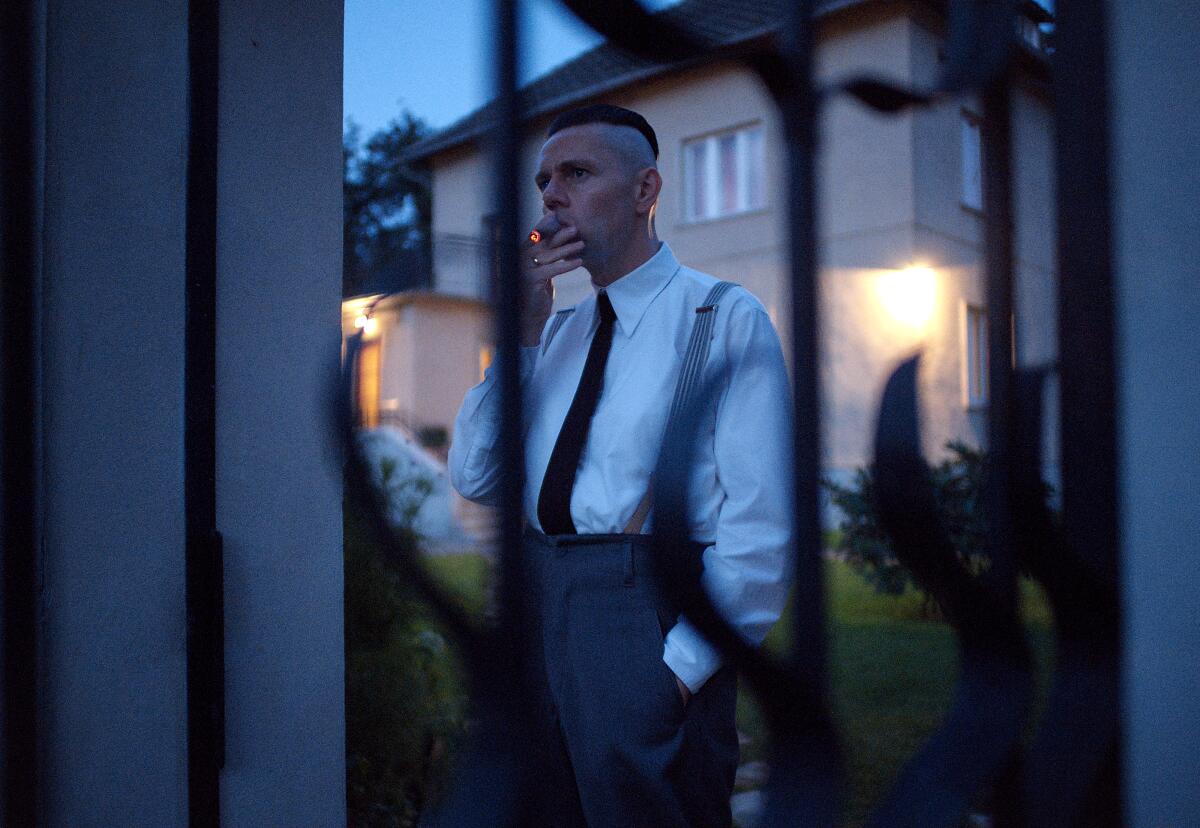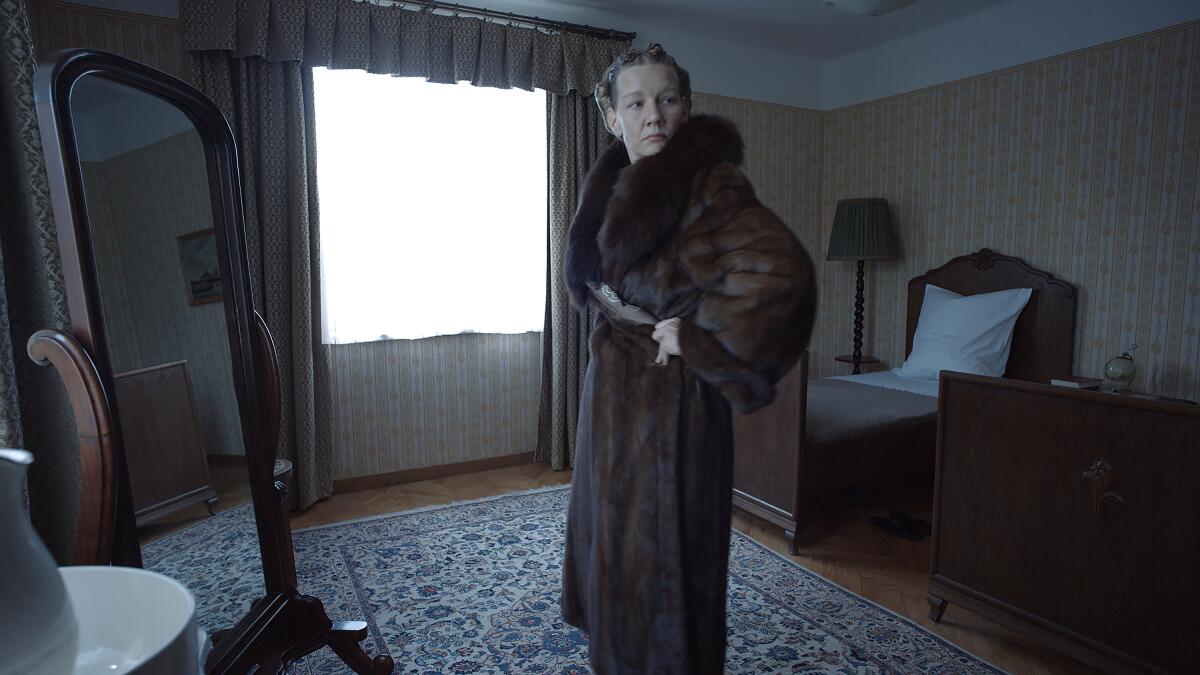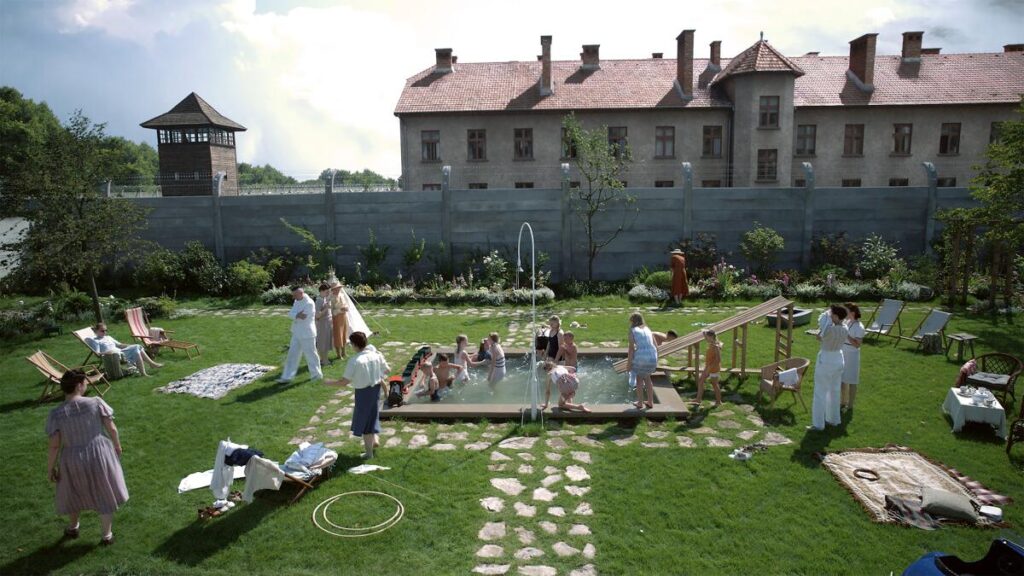To hear him describe it, eyes lighting up and arms blocking out the imaginary space, British filmmaker Jonathan Glazer has a happy place, his small post-production studio in London’s Camden. “It’s like a lab, actually,” he says, “just a room, but this size — a bit bigger. Twice the height. There’s a little mezzanine level up there, screen on the wall.”
Glazer then drops in his collaborators, a dream team: “Mica’s writing, Paul’s cutting, I’m making the tea,” he continues, referring to Mica Levi, the inspired, once-in-a-generation composer who Glazer first worked with on 2013’s “Under the Skin,” and Paul Watts, his longtime editor who dates back to their videos with Massive Attack and the Dead Weather. “We’re moving around, with one person informing the other.”
Meanwhile, sound designer Johnnie Burn, also recently of “Nope” and “Poor Things,” is on video hookup all day from Brighton, sharing ideas, trying out remixes on the fly. Watts is eating a sandwich. “It’s all very like that,” Glazer says. “And I think the fact that we are in the space together is how we get to where we get, because we are all in conversation with each other and with the film.”
Paradoxically, the film that has emerged from this happy arrangement is “The Zone of Interest” (in theaters), Glazer’s radical, disquieting reinvention of the Holocaust drama set just on the other side of the Auschwitz camp wall, where a Nazi commandant’s family somehow pretends to enjoy its private garden. As creatively nourishing as Glazer’s setup sounds, making the film was not easy, a process compounded by the director’s Kubrickian penchant for preparation and perfection. He spent a combined total of 19 years on his last two features, two on “Zone’s” post-production alone.
A scene from the movie “The Zone of Interest.”
(A24)
“I’m not somebody who’s going to call up an agent and say, ‘What scripts are out there? Send me something good,’” Glazer, 58, tells me. We’re speaking in a closed-door conference room that I’ve tried to make as un-West Hollywood as possible, dialing up the lights and ordering some black coffee. It’s a cool morning in L.A. and his cozy brown sweater makes sense. “It’s just not the world I’m in. It’s more something which happens inside me, which compels me to go down a certain road.”
Glazer’s work on the movie began in earnest in 2014, when he first read the newly published novel “The Zone of Interest” by the late Martin Amis, a fictionalized account set at Auschwitz that the filmmaker would ultimately re-research for years and jettison most of, including its central love triangle. But even before then, Glazer had been thinking about making a Holocaust movie — always, he knew, from the point of view of the perpetrators, not the victims.
Was turning 50 the spark that inspired his turn toward mortality? “It never seems to be that conscious with me,” he demurs about his choice of projects. “I just think there are things you come to at different times of your life. You’re examining different things at different stages, aren’t you, with the experiences that you’ve had.”
He remembers growing up in 1970s suburban Hadley Wood and attending a public Jewish school during an era he describes as “pretty unreconstructed.”
“Kids would come pouring out of the school gates to get on the buses and trains to go home at the end of the day,” Glazer recalls, “and you would put your blazers and ties in your bag so that you’d have no school colors to identify you. And you’d keep your head down, really, until you got home.”
It didn’t always work, he remembers, dodging the non-Jewish bullies up the road. “The fact that it was a Jewish school gave them ammunition for a bit of conflict — which happened,” he adds, darkly.
Glazer allows the idea that what drew him to make “The Zone of Interest” was a sense of responsibility to address his memories of antisemitism. “I hadn’t thought of it in those terms,” he says, “but yes, I would think there probably is a part of me that felt the need to point my abilities, whatever they may be, at that subject to see whether or not I could contribute to it. That’s a human responsibility, I think, before it’s a tribal one.”
Three years of research into Amis’ own sources led him to the real-life camp commandant Rudolf Höss, whose every mention in Auschwitz’s records was excavated by Glazer’s researchers. There was also Piotr Setkiewicz’s essential 2014 study “The Private Lives of the SS in Auschwitz” and its volumes of testimony, much of it by teenage Polish girls who worked in the Höss home and on the grounds.
“I became really struck by that,” Glazer says. “The horror was in the house. Fascism starts in the family anyway, so there was something about the ordinariness and the familiarity of that ordinariness. It was just utterly captivating.”

Christian Friedel in the movie “The Zone of Interest.”
(A24)
What Glazer discovered at bedrock were not the lip-curling monsters of Hollywood’s Holocaust movies but social climbers looking to improve their status. “What they had hoped for themselves and their petty bourgeois dreams — they’re not that different from ours at all,” he says. It wasn’t sympathy he was arriving at, so much as clarity.
The filmmaker’s research took him through the gates of hell themselves, where he remembers making a shattering realization. There was a single camera roll of film in the Auschwitz archive, likely taken by Höss himself, of parties and children.
“And this is a happy family in a back garden getting on with their lives,” he says of the shots. “There’s no evidence in this roll of film that the camp wall was in fact the garden wall. He didn’t shoot it. So that tells you a lot.”
Moments like these, by Glazer’s own admission, drove him close to abandoning “Zone” as detrimental to his mental health. “It’s just too much darkness, too much weight, too much responsibility,” he recalls. “And you begin to question your motives and it’s a sh— place to find yourself. And I remember my wife said to me, ‘But your job is to turn that camera around and shoot that wall that they didn’t shoot. That’s exactly what you’re doing there.’”
He also remembers standing on the camp side of the wall opposite where the Höss structure still stands. “You would have heard kids splashing in the pool,” Glazer says. “It’s the compartmentalization made manifest. I knew that wall was the center of the entire project.”
Shouldering the weight of the situation without recourse to sentiment became the hardest trial of Glazer’s career. He ended up shooting his film on location in an adjacent house on Auschwitz’s perimeter, the camp’s towers in view. Cameras and microphones would be concealed from the cast so as to approach the most unflinching reality possible.
“I didn’t want to get caught up in the screen psychology of an actor,” Glazer says. “I felt like I needed to somehow film this as if I was filming the real people. I needed to believe that they were the people they were portraying before I could have anybody else believe.”

Sandra Hüller in the movie “The Zone of Interest.”
(A24)
Those are tall asks of any actor. Sandra Hüller, so electrifying in “Toni Erdmann” and this year’s courtroom thriller “Anatomy of a Fall,” required, by Glazer’s estimation, a year of persuasion before committing to the part of Höss’ wife, Hedwig. “I think she was made more comfortable by my doubts rather than my certainties,” the director says. “But I knew I absolutely had to have her for that role.”
Whatever Hüller was wrestling over, it was surely as difficult as what was asked of Christian Friedel, chosen to play Höss himself.
“I didn’t want Christian to pretend to vomit — I wanted him to vomit and he couldn’t,” Glazer recalls, smiling sheepishly at the hard ask he made during the filming of one of “Zone’s” most nightmarish scenes. (The Kubrick comparisons are not unmerited.) Ultimately, actor and director studied a notorious scene in Joshua Oppenheimer’s 2012 documentary “The Act of Killing,” in which an Indonesian mass murderer vomits almost in mutiny with his own mind. “There’s always a way around,” Glazer says, leaving the technical specifics a mystery.
His first feature, 2000’s “Sexy Beast,” was a viciously funny movie about British gangsters, one struck by comedic moments of dreamlike surrealism. “Birth,” starring Nicole Kidman as a Manhattan widow who begins to suspect a young boy is in fact her reincarnated dead husband, was also his. “Under the Skin” is about aliens. Glazer’s dogged pursuit of realism at all costs feels new to him, and it speaks to the seriousness of his rigor. He doesn’t pretend it was easy.
“I needed light in there,” he remembers of the toughest moments of making his latest. “I needed light in myself to carry on. I needed something holy.”
A kind of salvation arrived in one of Glazer’s interviews during his prep period — a 90-year-old Polish woman who secretly bicycled in the middle of the night as a girl, leaving food behind for the prisoners.
“When I met her, I really felt that I’d met this angel,” Glazer says. “I had seen that there was light there too. There was that other thing that is in us as human beings.”

An image from the movie “The Zone of Interest.”
(A24)
He includes these episodes in the film, shot in stark black-and-white thermal photography — almost like an X-ray world — punctuated by some of composer Levi’s most disturbing noises, like belches from hell. It’s hard to imagine the movie without these night flights. “It is literally the inverse of everything else we’ve been seeing in the film,” Glazer says.
Since last May’s Cannes Film Festival, where “The Zone of Interest” won the Grand Prix (an award second only to the Palme d’Or), Glazer has relaxed somewhat, though he admits to being surprised — and moved — by the rapturous reaction he received in France. Strangers approached him, shaken, not even with questions but simply wanting to be heard.
“There was something cathartic about it that they wanted to share,” he recalls. “And it was at that moment — just people in the street, young and old — when it really hit me that I just thought, Oh, my goodness, there might be something going on here that’s outside of the film.”
Glazer pauses, a wave of humility bringing back all the questions that preoccupied him from the start a decade ago. “Am I doing this because I want to make a Holocaust movie?” he asks. “Why am I here? What am I doing this for? Why me? Just who do I think I am to take this on? I have those doubts all the time. I lose huge amounts of sleep over this — I still do.”
His next film, he tells me, will be about “tenderness — how tender we can be as well.” It won’t come for a while. Meanwhile, there is the position Glazer now finds himself in, releasing his most celebrated effort in a reinvigorated awards season, with the wider implications of making a movie about violent political disassociation available to anyone who wants them.
“Of course it speaks to this moment,” Glazer says. “Of course it does. But it’s about who we are as a species and what we are capable of. I think the film has alarm in it. It certainly was made with that intention. We’re trying to ring a warning.”

